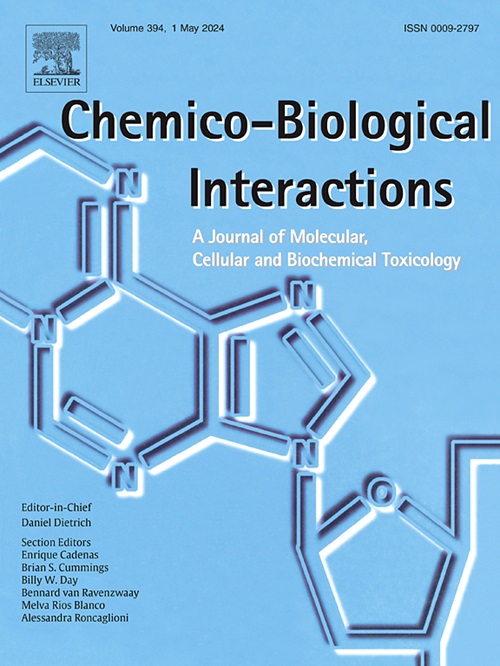EGCG通过激活TFEB介导的自噬作用,抑制肾细胞癌的迁移、侵袭和上皮-间质转化。
IF 4.7
2区 医学
Q1 BIOCHEMISTRY & MOLECULAR BIOLOGY
引用次数: 0
摘要
背景:肾细胞癌(RCC)的发病率已超过 4%,位居各类癌症的前十位。表没食子儿茶素没食子酸酯(EGCG)是从绿茶中提取的一种多酚化合物,已被证明可有效治疗多种肿瘤。然而,关于表没食子儿茶素没食子酸酯(EGCG)对 RCC 的影响及其潜在分子机制的研究还很有限:方法:暴露于梯度浓度(0,5,10,20,40,60,80,100 μM)的EGCG后,用MTT法测定RCC细胞的活力。通过伤口愈合和透孔试验研究了 RCC 细胞的迁移和侵袭能力。通过 Western 印迹法检测了参与上皮-间质转化(EMT)和自噬的蛋白质的表达水平。通过电子显微镜和 LC3 点检测自噬体的形成。裸鼠异种移植模型作为体内模型系统:结果:在本研究中,EGCG能显著抑制RCC细胞的迁移、侵袭和EMT。对其机制的进一步探讨表明,自噬参与了EGCG介导的RCC细胞转移抑制和EMT抑制。此外,EGCG还能显著上调转录因子EB(TFEB)并促进其核定位。TFEB进入细胞核后会提高自噬相关分子的转录水平。TFEB敲除抑制了EGCG介导的RCC细胞自噬激活、转移和EMT抑制:总之,这些研究结果首次证明了EGCG通过激活TFEB介导的自噬作用来抑制RCC的迁移、侵袭和EMT。因此,EGCG与TFFB激活剂或EMT抑制剂的结合有望成为一种治疗RCC的有效策略。本文章由计算机程序翻译,如有差异,请以英文原文为准。
EGCG inhibits migration, invasion and epithelial-mesenchymal transition of renal cell carcinoma by activating TFEB-mediated autophagy
Background
The incidence of renal cell carcinoma (RCC) is already in the top ten of all types of cancers, with more than 4 %. Epigallocatechin gallate (EGCG), a polyphenolic compound extracted from green tea, has been shown to be effective in the treatment of various tumors. However, limited studies have demonstrated the effect of EGCG on RCC and its underlying molecular mechanisms.
Methods
After exposure to gradient concentration (0,5,10,20,40,60,80,100 μM) of EGCG, the cell viability of RCC cells was determined by MTT assay. The migration and invasion abilities of RCC cells were investigated by wound healing and transwell assays. The expression levels of proteins involved in the epithelial-mesenchymal transition (EMT) and autophagy were explored by Western blotting assays. The formation of autophagosome was detected by electron microscope and LC3 puncta assays. Nude mouse xenograft model was used as the model system in vivo.
Results
In the present study, EGCG significantly inhibited the migration, invasion and EMT of RCC cells in a concentrated manner. Further exploration of its mechanism indicated that autophagy is involved in EGCG-mediated metastasis inhibition and EMT inhibition of RCC cells. In addition, EGCG could significantly up-regulate the transcription factor EB (TFEB) and promotes its nuclear localization. The incorporation of TFEB into the nucleus enhanced the transcriptional levels of molecules associated with autophagy. TFEB knockdown inhibited EGCG-mediated autophagy activation, metastasis and EMT inhibition in RCC cells.
Conclusions
In conclusion, these findings demonstrate for the first time that EGCG inhibits migration, invasion, and EMT of RCC by activating TFEB-mediated autophagy. Therefore, the combination of EGCG and TFFB activators or EMT inhibitors is expected to be a promising therapeutic strategy for RCC.
求助全文
通过发布文献求助,成功后即可免费获取论文全文。
去求助
来源期刊
CiteScore
7.70
自引率
3.90%
发文量
410
审稿时长
36 days
期刊介绍:
Chemico-Biological Interactions publishes research reports and review articles that examine the molecular, cellular, and/or biochemical basis of toxicologically relevant outcomes. Special emphasis is placed on toxicological mechanisms associated with interactions between chemicals and biological systems. Outcomes may include all traditional endpoints caused by synthetic or naturally occurring chemicals, both in vivo and in vitro. Endpoints of interest include, but are not limited to carcinogenesis, mutagenesis, respiratory toxicology, neurotoxicology, reproductive and developmental toxicology, and immunotoxicology.

 求助内容:
求助内容: 应助结果提醒方式:
应助结果提醒方式:


